An Artificial Neural Network Model to Predict Efficiency and Emissions of a Gasoline Engine
Abstract
:1. Introduction
2. Materials and Methods
3. Results and Discussions
4. Summary and Conclusions
- In order to achieve better prediction results, this study compared the prediction results of three different ANN model structures (including 3-7-6, 3-7-7-6, and 3-5-5-6), and the results showed that among these three prediction results, the lowest R2 of the prediction results of 3-7-7-6 basically remained around ≈0.98, which was higher than the R2 of the other two ANN models. Almost metrics predicted less RMSE values than those of the other two structures, which indicates that a 3-7-7-6 neuron network can achieve the better prediction results for each parameter (including power, emission, and phasing indicators).
- Using three types of variables (including six parameters) as output parameters and spark timing, speed, and intake pressure as input indicators with one ANN model, this can achieve good prediction results with close-to-unity R2 and relatively small RMSE. In the future, the whole vehicle only needs one controller in the optimization of powertrain system control strategies, and the results indicated the integration is possible.
- For the testing dataset, the ANN model can learn the trends between inputs and engine responses, which indicates that ANN can learn some internal intrinsic connections, which may be because some parameters of the chain chemical reaction can be learned by ANN. Therefore, the future ML model can be used to assist the engine design in the future.
Author Contributions
Funding
Institutional Review Board Statement
Informed Consent Statement
Data Availability Statement
Acknowledgments
Conflicts of Interest
Abbreviations
| 1D | One-Dimensional |
| ATDC | After Top Dead Center |
| ANN | Artificial Neural Network |
| BDT | Boosted Decision Tree |
| BP | Back Propagation |
| BSFC | Brake Specific Fuel Consumption |
| CAD | Crank Angle Degree |
| CA50 | 50% Burned Crank Angle |
| CFD | Computational Fluid Dynamics |
| CO | Carbon Monoxide |
| EGT | Exhaust Gas Temperature |
| ICEs | Internal Combustion Engines |
| IMEP | Indicated Mean Effective Pressure |
| ITE | Indicated Thermal Efficiency |
| MBD | Model-Based Design |
| MBT | Maximum Brake Torque |
| ML | Machine Learning |
| NOx | Nitrogen Oxides |
| R2 | Coefficient of Determination |
| RF | Random Forest |
| RMSE | Root Mean Squared Error |
| SI | Spark Ignition |
| SSres | Sum of Squares Due to Regression |
| SStot | Sum of squares Due to Error |
| ST | Spark Timing |
| SVR | Support Vector Regression |
| UHC | Unburned Hydrocarbons |
References
- Yang, R.; Sun, X.; Liu, Z.; Zhang, Y.; Fu, J. A numerical analysis of the effects of equivalence ratio measurement accuracy on the engine efficiency and emissions at varied compression ratios. Processes 2021, 9, 1413. [Google Scholar] [CrossRef]
- Liu, J.; Dumitrescu, C.E. 3D CFD simulation of a CI engine converted to SI natural gas operation using the G-equation. Fuel 2018, 232, 833–844. [Google Scholar] [CrossRef]
- Liu, J.; Dumitrescu, C.E. Combustion partitioning inside a natural gas spark ignition engine with a bowl-in-piston geometry. Energy Convers. Manag. 2019, 183, 73–83. [Google Scholar] [CrossRef]
- Liu, J.; Ulishney, C.J.; Dumitrescu, C.E. Experimental investigation of a heavy-duty natural gas engine performance operated at stoichiometric and lean operations. Energy Convers. Manag. 2021, 243, 114401. [Google Scholar] [CrossRef]
- Feser, J.; Gupta, A. Performance and emissions of drop-in aviation biofuels in a lab-scale gas turbine combustor. J. Energy Resour. Technol. 2021, 143, 042103. [Google Scholar] [CrossRef]
- Chong, C.T.; Chiong, M.C.; Ng, J.H.; Tran, M.V.; Valera-Medina, A.; Józsa, V.; Tian, B. Dual-fuel operation of biodiesel and natural gas in a model gas turbine combustor. Energy Fuels 2020, 34, 3788–3796. [Google Scholar] [CrossRef]
- Yan, Z.; Gainey, B.; Gohn, J.; Hariharan, D.; Saputo, J.; Schmidt, C.; Caliari, F.; Sampath, S.; Lawler, B. A comprehensive experimental investigation of low-temperature combustion with thick thermal barrier coatings. Energy 2021, 222, 119954. [Google Scholar] [CrossRef]
- Yan, Z.; Gainey, B.; Lawler, B. A parametric modeling study of thermal barrier coatings in low-temperature combustion engines. Appl. Therm. Eng. 2022, 200, 117687. [Google Scholar] [CrossRef]
- Ambrogi, L.; Liu, J.; Battistoni, M.; Dumitrescu, C.; Gasbarro, L. CFD investigation of the effects of gas’ methane number on the performance of a heavy-duty natural-gas spark-ignition engine. SAE Tech. Pap. 2019. [Google Scholar] [CrossRef]
- Gasbarro, L.; Liu, J.; Dumitrescu, C.; Ulishney, C.; Battistoni, M.; Ambrogi, L. Heavy-duty compression-ignition engines retrofitted to spark-ignition operation fueled with natural gas. SAE Tech. Pap. 2019. [Google Scholar] [CrossRef]
- Liu, J.; Ulishney, C.J.; Dumitrescu, C.E. Effect of spark timing on the combustion stages seen in a heavy-duty compression-ignition engine retrofitted to natural gas spark-ignition operation. SAE Int. J. Engines 2021, 14, 335–344. [Google Scholar] [CrossRef]
- Liu, J.; Dumitrescu, C.E. Analysis of two-stage natural-gas lean combustion inside a diesel geometry. Appl. Therm. Eng. 2019, 160, 114116. [Google Scholar] [CrossRef]
- Kapusuz, M.; Ozcan, H.; Yamin, J.A. Research of performance on a spark ignition engine fueled by alcohol–gasoline blends using artificial neural networks. Appl. Therm. Eng. 2015, 91, 525–534. [Google Scholar] [CrossRef]
- Gainey, B.; Yan, Z.; Lawler, B. Autoignition characterization of methanol, ethanol, propanol, and butanol over a wide range of operating conditions in LTC/HCCI. Fuel 2021, 287, 119495. [Google Scholar] [CrossRef]
- Böyükdipi, Ö.; Tüccar, G.; Soyhan, H.S. Experimental investigation and artificial neural networks (ANNs) based prediction of engine vibration of a diesel engine fueled with sunflower biodiesel—NH3 mixtures. Fuel 2021, 304, 121462. [Google Scholar] [CrossRef]
- Silitonga, A.S.; Masjuki, H.H.; Ong, H.C.; Sebayang, A.H.; Dharma, S.; Kusumo, F.; Siswantoro, J.; Milano, J.; Daud, K.; Mahlia, T.M.I.; et al. Evaluation of the engine performance and exhaust emissions of biodiesel-bioethanol-diesel blends using kernel-based extreme learning machine. Energy 2018, 159, 1075–1087. [Google Scholar] [CrossRef]
- Stocchi, I.; Liu, J.; Dumitrescu, C.E.; Battistoni, M.; Grimaldi, C.N. Effect of piston crevices on the numerical simulation of a heavy-duty diesel engine retrofitted to natural-gas spark-ignition operation. J. Energy Resour. Technol. 2019, 141, 112204. [Google Scholar] [CrossRef]
- Liu, J.; Szybist, J.; Dumitrescu, C. Choice of tuning parameters on 3D IC engine simulations using G-equation. SAE Tech. Pap. 2018. [Google Scholar] [CrossRef]
- Ahmad, M.W.; Mourshed, M.; Rezgui, Y. Trees vs Neurons: Comparison between random forest and ANN for high-resolution prediction of building energy consumption. Energy Build. 2017, 147, 77–89. [Google Scholar] [CrossRef]
- Sadat-Mohammadi, M.; Shakerian, S.; Liu, Y.; Asadi, S.; Jebelli, H. Non-invasive physical demand assessment using wearable respiration sensor and random forest classifier. J. Build. Eng. 2021, 44, 103279. [Google Scholar] [CrossRef]
- Suryadevara, N.K. Energy and latency reductions at the fog gateway using a machine learning classifier. Sustain. Comput. Inform. Syst. 2021, 31, 100582. [Google Scholar] [CrossRef]
- Pai, P.S.; Rao, B.S. Artificial neural network based prediction of performance and emission characteristics of a variable compression ratio CI engine using WCO as a biodiesel at different injection timings. Appl. Energy 2011, 88, 2344–2354. [Google Scholar]
- Douna, V.; Barraza, V.; Grings, F.; Huete, A.; Restrepo-Coupe, N.; Beringer, J. Towards a remote sensing data based evapotranspiration estimation in Northern Australia using a simple random forest approach. J. Arid. Environ. 2021, 191, 104513. [Google Scholar] [CrossRef]
- Sayin, C.; Ertunc, H.M.; Hosoz, M.; Kilicaslan, I.; Canakci, M. Performance and exhaust emissions of a gasoline engine using artificial neural network. Appl. Therm. Eng. 2007, 27, 46–54. [Google Scholar] [CrossRef]
- Oliphant, A.J.; Thenkabail, P.S.; Teluguntla, P.; Xiong, J.; Gumma, M.K.; Congalton, R.G.; Yadav, K. Mapping cropland extent of Southeast and Northeast Asia using multi-year time-series Landsat 30-m data using a random forest classifier on the Google Earth Engine Cloud. Int. J. Appl. Earth Obs. Geoinf. 2019, 81, 110–124. [Google Scholar] [CrossRef]
- Huang, Q.; Liu, J. Practical limitations of lane detection algorithm based on Hough transform in challenging scenarios. Int. J. Adv. Robot. Syst. 2021, 18, 17298814211008752. [Google Scholar] [CrossRef]
- Liu, J.; Wang, H. Machine learning assisted modeling of mixing timescale for LES/PDF of high-Karlovitz turbulent premixed combustion. Combust. Flame 2022, 238, 111895. [Google Scholar] [CrossRef]
- Liu, J.; Ulishney, C.J.; Dumitrescu, C.E. Comparative performance of machine learning algorithms in predicting nitrogen oxides emissions of a heavy duty natural gas spark ignition engine. In Proceedings of the International Conference on Applied Energy, Virtual, 29 November–2 December 2021. [Google Scholar]
- Liu, J.; Ulishney, C.J.; Dumitrescu, C.E. Application of random forest machine learning models to forecast combustion profile parameters of a natural gas spark ignition engine. In Proceedings of the American Society of Mechanical Engineers International Mechanical Engineering Congress and Exposition, Virtual, Online, 16–19 November 2020. [Google Scholar] [CrossRef]
- Oh, H.; Hwang, J.; Pickett, L.M.; Han, D. Machine-learning based prediction of injection rate and solenoid voltage characteristics in GDI injectors. Fuel 2021, 92, 122569. [Google Scholar] [CrossRef]
- Yang, R.; Sun, X.; Liu, Z.; Zhang, Y.; Fu, J. A numerical study into the importance of equivalence ratio measurement accuracy for spark ignition engines. In Proceedings of the ASME 2021 International Mechanical Engineering Congress and Exposition, Virtual, Online, 1–5 November 2021. [Google Scholar]
- Liu, J.; Ulishney, C.J.; Dumitrescu, C.E. Predicting the combustion phasing of a natural gas spark ignition engine using the k-nearest neighbors algorithm. In Proceedings of the American Society of Mechanical Engineers International Mechanical Engineering Congress and Exposition, Virtual, Online, 16–19 November 2020. [Google Scholar] [CrossRef]
- Parlak, A.; Islamoglu, Y.; Yasar, H.; Egrisogut, A. Application of artificial neural network to predict specific fuel consumption and exhaust temperature for a diesel engine. Appl. Therm. Eng. 2006, 26, 824–828. [Google Scholar] [CrossRef]
- Mohammadhassani, J.; Dadvand, A.; Khalilarya, S.; Solimanpur, M. Prediction and reduction of diesel engine emissions using a combined ANN–ACO method. Appl. Soft Comput. 2015, 34, 139–150. [Google Scholar] [CrossRef]
- Liu, J.; Huang, Q.; Ulishney, C.; Dumitrescu, C.E. Comparison of random forest and neural network in modeling the performance and emissions of a natural gas spark ignition engine. J. Energy Resour. Technol. 2022, 144, 032310. [Google Scholar] [CrossRef]
- Hoang, A.T.; Nižetić, S.; Ong, H.C.; Tarelko, W.; Le, T.H.; Chau, M.Q.; Nguyen, X.P. A review on application of artificial neural network (ANN) for performance and emission characteristics of diesel engine fueled with biodiesel-based fuels. Sustain. Energy Technol. Assess. 2021, 47, 101416. [Google Scholar]
- Liu, J.; Ulishney, C.J.; Dumitrescu, C.E. Random forest machine learning model for predicting combustion feedback information of a natural gas spark ignition engine. J. Energy Resour. Technol. 2021, 143, 012301. [Google Scholar] [CrossRef]
- Di Mauro, A.; Chen, H.; Sick, V. Neural network prediction of cycle-to-cycle power variability in a spark-ignited internal combustion engine. Proc. Combust. Inst. 2019, 37, 4937–4944. [Google Scholar] [CrossRef]
- Ismail, H.M.; Ng, H.K.; Queck, C.W.; Gan, S. Artificial neural networks modelling of engine-out responses for a light-duty diesel engine fuelled with biodiesel blends. Appl. Energy 2012, 92, 769–777. [Google Scholar] [CrossRef]
- Liu, J.; Huang, Q.; Ulishney, C.; Dumitrescu, C.E. Prediction of exhaust gas temperature of a natural gas spark ignition engine using machine learning methods. In Proceedings of the International Conference on Applied Energy, Virtual, 1–10 December 2020. [Google Scholar]
- Liu, J.; Ulishney, C.; Dumitrescu, C.E. Prediction of efficient operating conditions inside a heavy-duty natural gas spark ignition engine using artificial neural networks. In Proceedings of the American Society of Mechanical Engineers International Mechanical Engineering Congress and Exposition, Virtual, Online, 16–19 November 2020. [Google Scholar] [CrossRef]
- Liu, J.; Ulishney, C.; Dumitrescu, C.E. Improving machine learning model performance in predicting the indicated mean effective pressure of a natural gas engine. In Proceedings of the American Society of Mechanical Engineers Internal Combustion Engine Division Fall Technical Conference, Virtual, Online, 4–6 November 2020. [Google Scholar] [CrossRef]
- Korres, D.M.; Anastopoulos, G.; Lois, E.; Alexandridis, A.; Sarimveis, H.; Bafas, G. A neural network approach to the prediction of diesel fuel lubricity. Fuel 2002, 81, 1243–1250. [Google Scholar] [CrossRef]
- Deng, Y.; Zhu, M.; Xiang, D.; Cheng, X. An analysis for effect of cetane number on exhaust emissions from engine with the neural network. Fuel 2002, 81, 1963–1970. [Google Scholar]
- Gamo, S.O.; Ouladsine, M.; Rachid, A. Diesel engine exhaust emissions modelling using artificial neural networks. SAE Tech. Pap. 1999. [Google Scholar] [CrossRef]
- Obodeh, O.; Ajuwa, C.I. Evaluation of artificial neural network performance in predicting diesel engine NOx emissions. Eur. J. Sci. Res. 2009, 33, 642–653. [Google Scholar]
- Togun, N.K.; Baysec, S. Prediction of torque and specific fuel consumption of a gasoline engine by using artificial neural networks. Appl. Energy 2010, 87, 349–355. [Google Scholar] [CrossRef]
- Brusca, S.; Lanzafame, R.; Messina, M. Neural Network application to evaluate thermodynamic properties of ICE’s combustion gases. SAE Tech. Pap. 2005. [Google Scholar] [CrossRef]
- Li, Y.; Jia, M.; Han, X.; Bai, X.S. Towards a comprehensive optimization of engine efficiency and emissions by coupling artificial neural network (ANN) with genetic algorithm (GA). Energy 2021, 225, 120331. [Google Scholar] [CrossRef]
- Ghobadian, B.; Rahimi, H.; Nikbakht, A.M.; Najafi, G.; Yusaf, T.F. Diesel engine performance and exhaust emission analysis using waste cooking biodiesel fuel with an artificial neural network. Renew. Energy 2009, 34, 976–982. [Google Scholar] [CrossRef] [Green Version]
- Negnevitsky, M. Artificial Intelligence: A Guide to Intelligent Systems; Pearson Education: London, UK, 2005. [Google Scholar]
- Rajkumar, S.; Das, A.; Thangaraja, J. Integration of artificial neural network, multi-objective genetic algorithm and phenomenological combustion modelling for effective operation of biodiesel blends in an automotive engine. Energy 2022, 239, 121889. [Google Scholar] [CrossRef]
- Fu, J.; Yang, R.; Li, X.; Sun, X.; Li, Y.; Liu, Z.; Zhang, Y.; Sunden, B. Application of artificial neural network to forecast engine performance and emissions of a spark ignition engine. Appl. Therm. Eng. 2022, 201, 117749. [Google Scholar] [CrossRef]
- Huang, Q.; Liu, J.; Ulishney, C.; Dumitrescu, C.E. On the use of artificial neural networks to model the performance and emissions of a heavy-duty natural gas spark ignition engine. Int. J. Engine Res. 2021, 14680874211034409. [Google Scholar] [CrossRef]
- Liu, J.; Huang, Q.; Ulishney, C.; Dumitrescu, C.E. Machine learning assisted prediction of exhaust gas temperature of a heavy-duty natural gas spark ignition engine. Appl. Energy 2021, 300, 117413. [Google Scholar] [CrossRef]
- Liu, J.; Huang, Q.; Ulishney, C.; Dumitrescu, C.E. A support-vector machine model to predict the dynamic performance of a heavy-duty natural gas spark ignition engine. SAE Tech. Pap. 2021. [Google Scholar] [CrossRef]
- Heywood, J.B. Internal Combustion Engine Fundamentals; McGraw-Hill: New York, NY, USA, 1988. [Google Scholar]

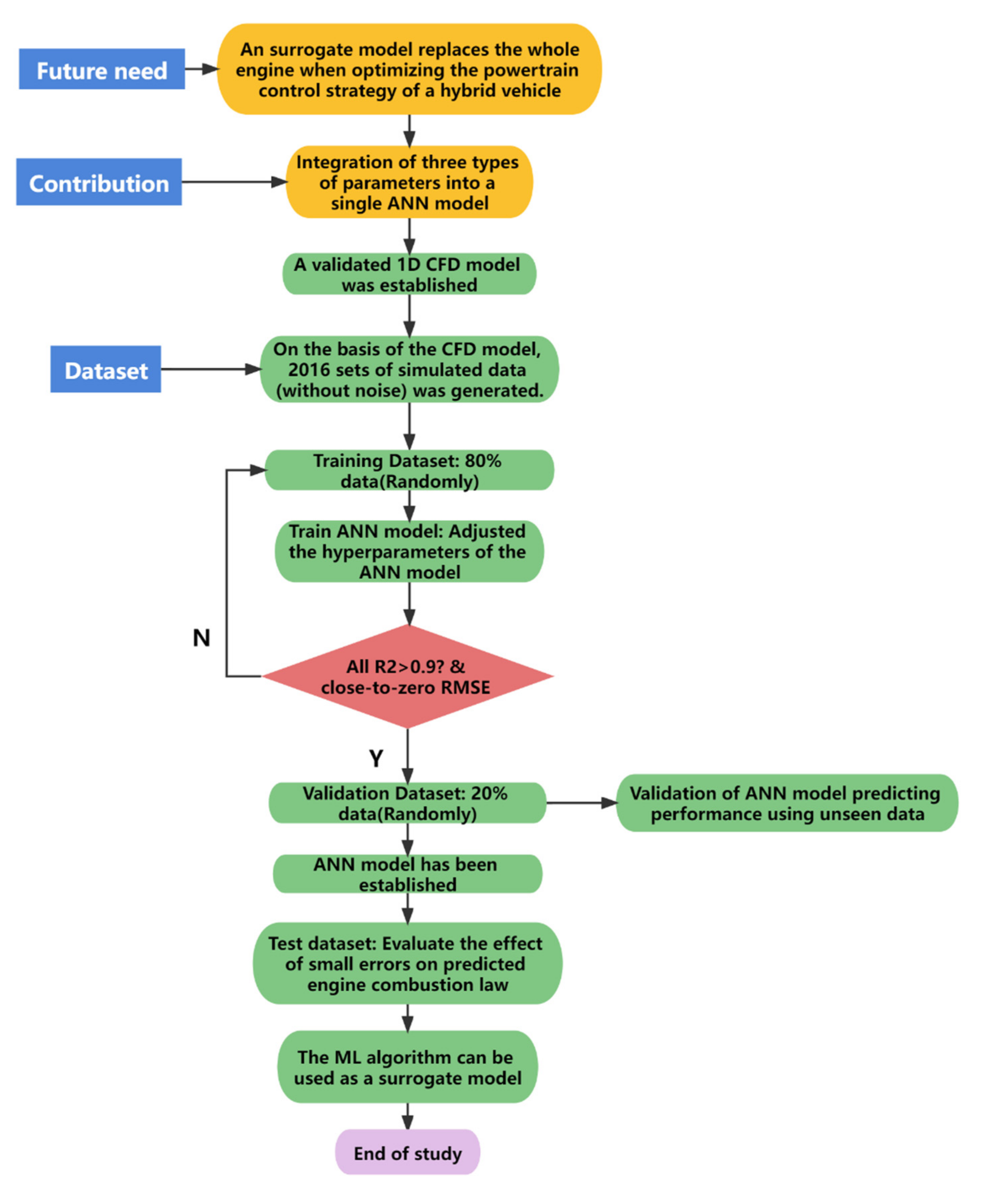
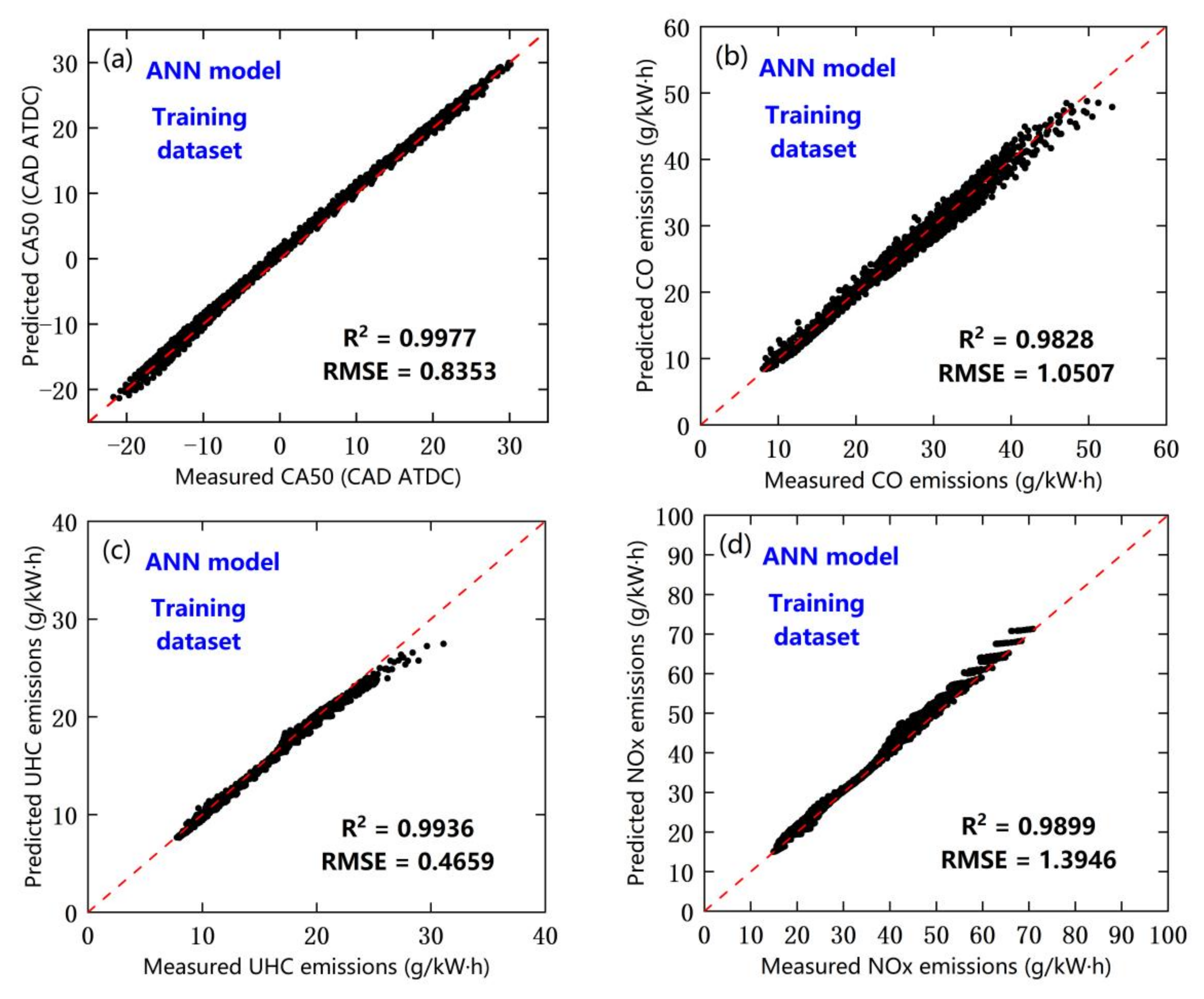

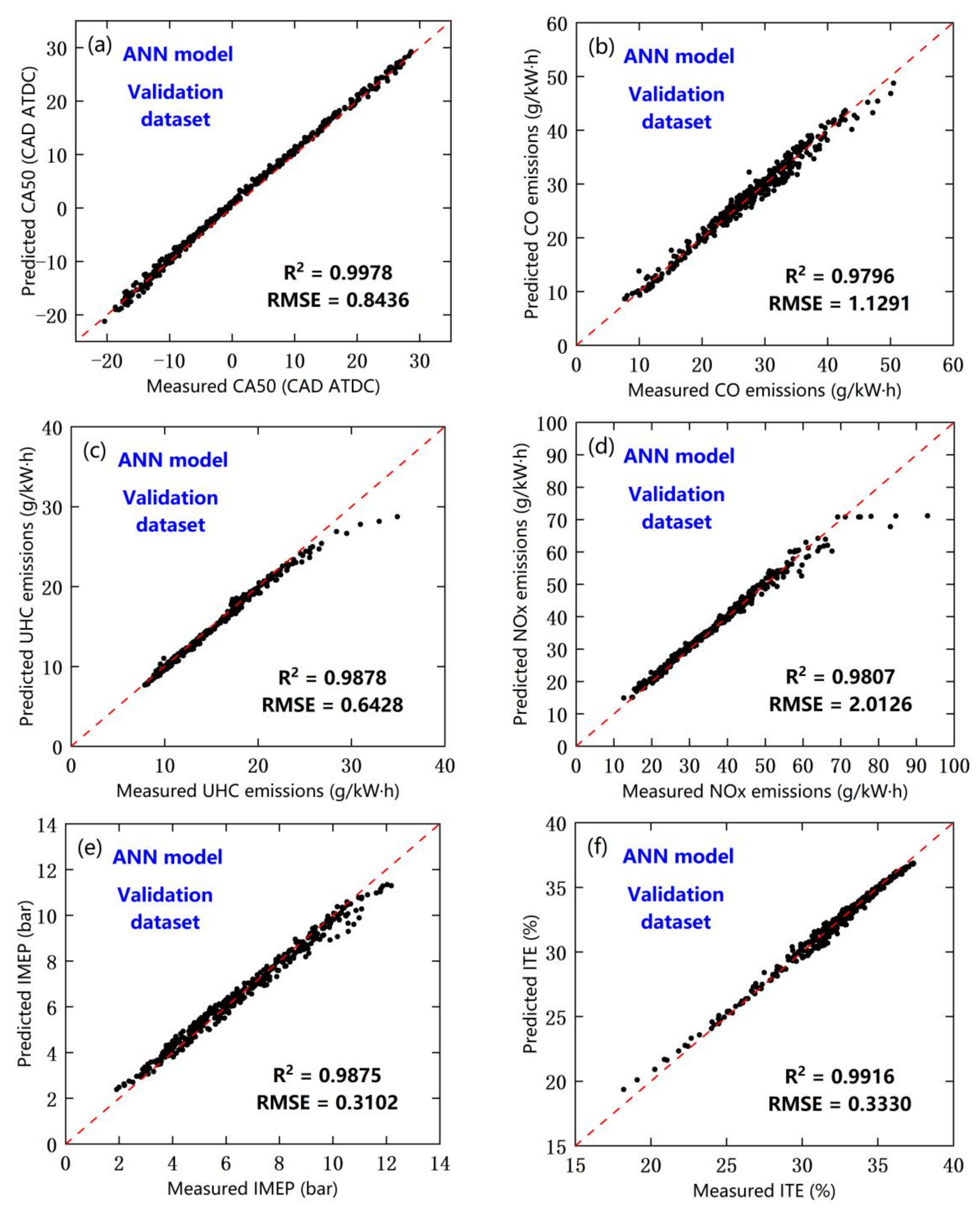
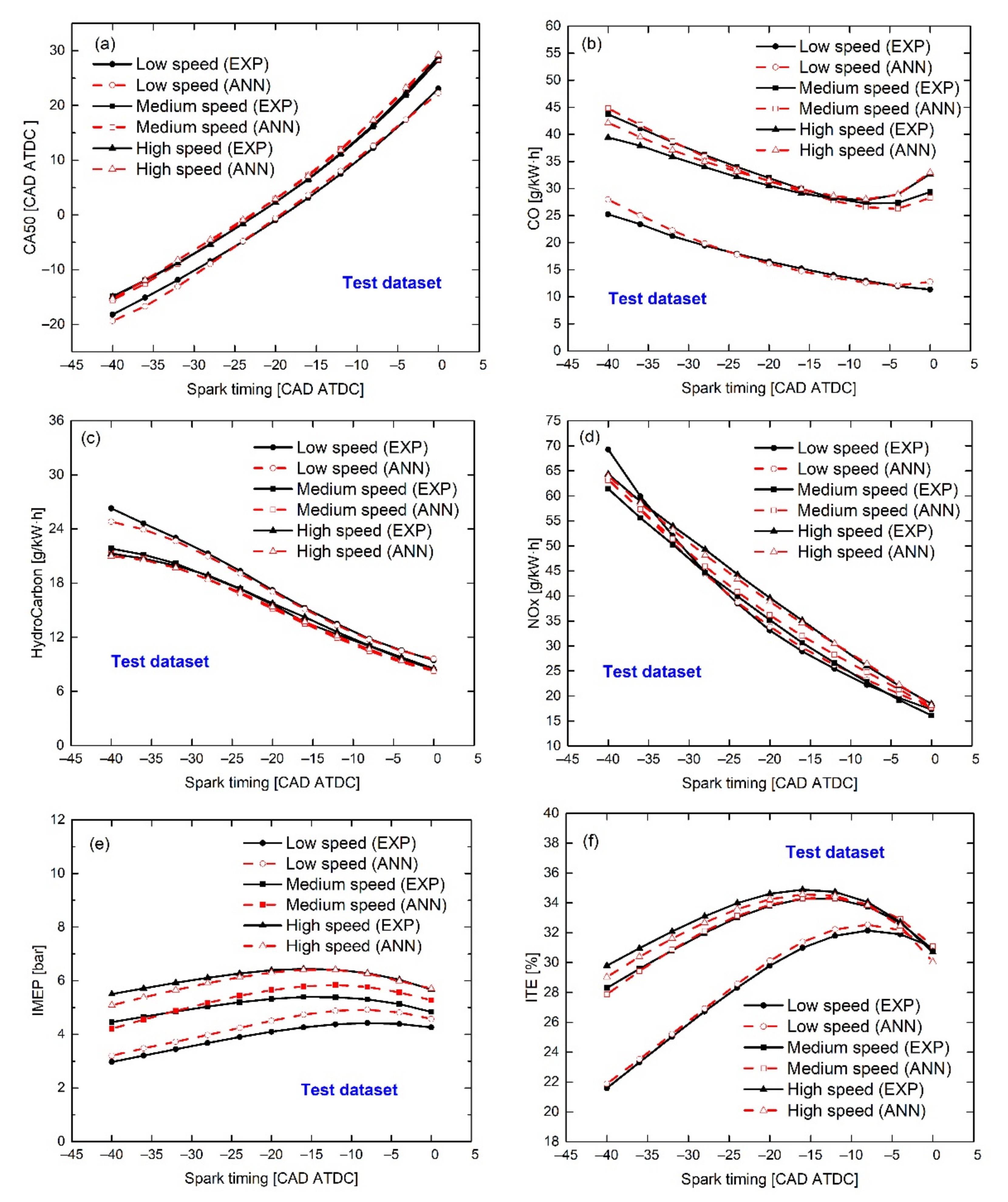
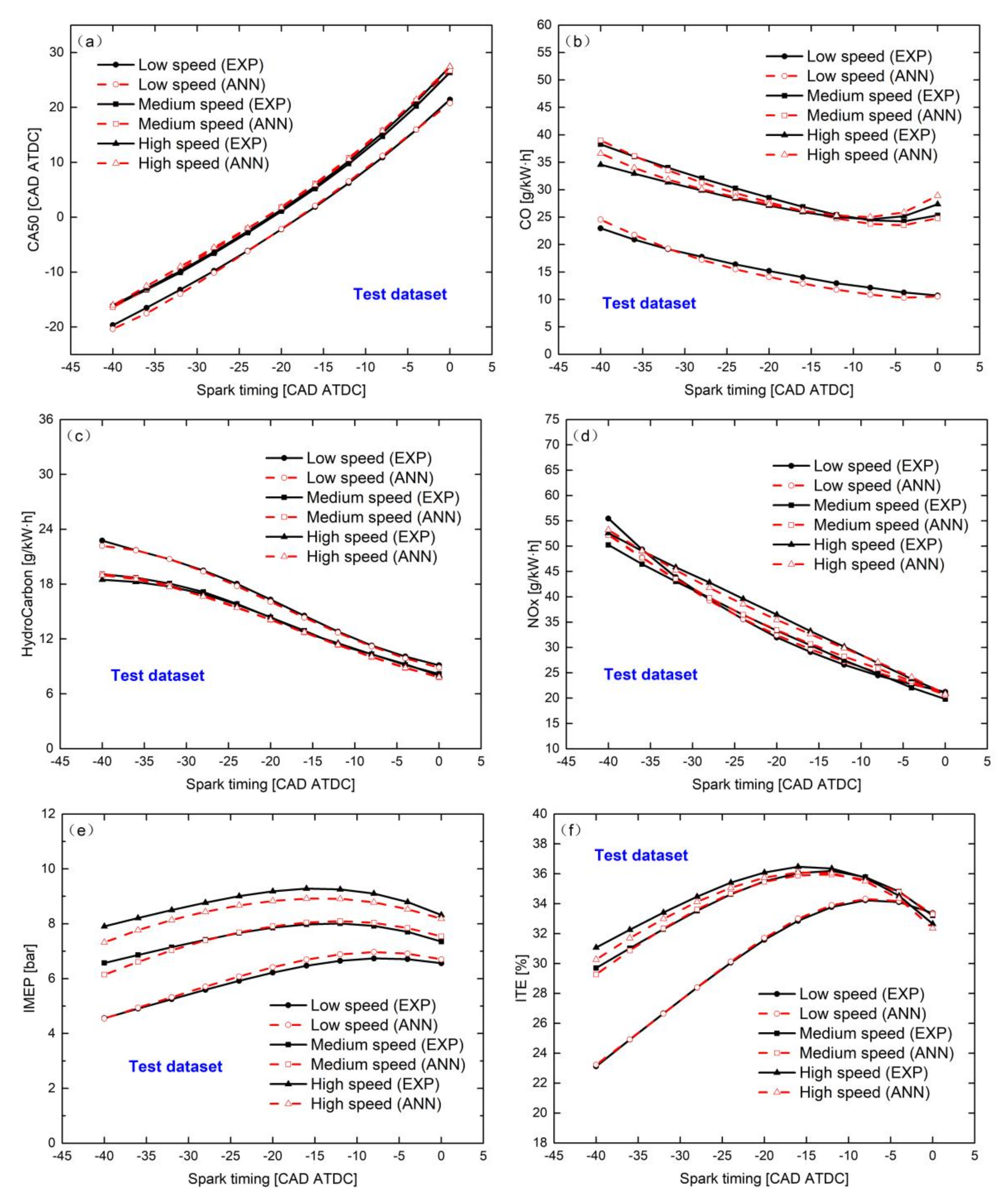
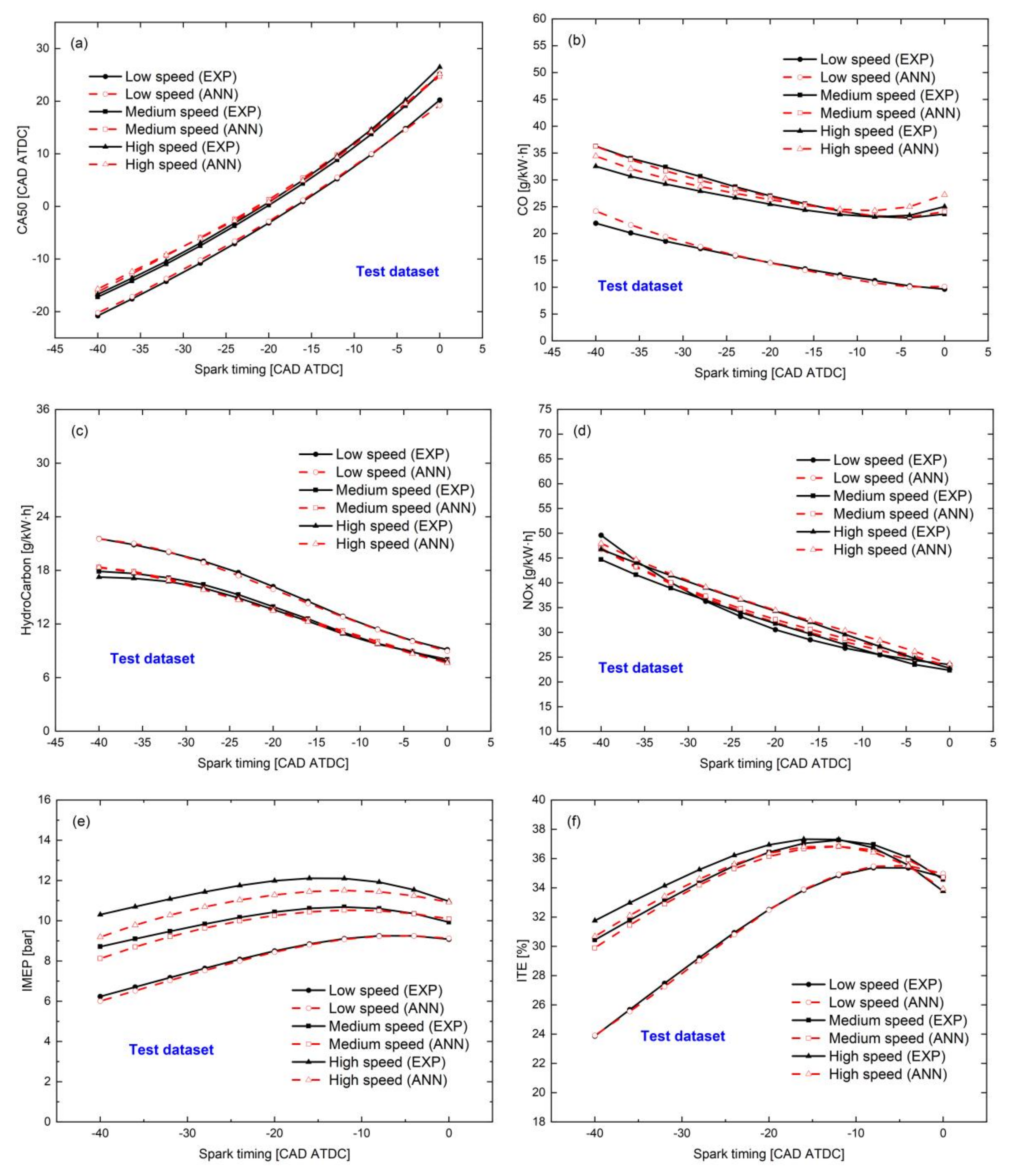
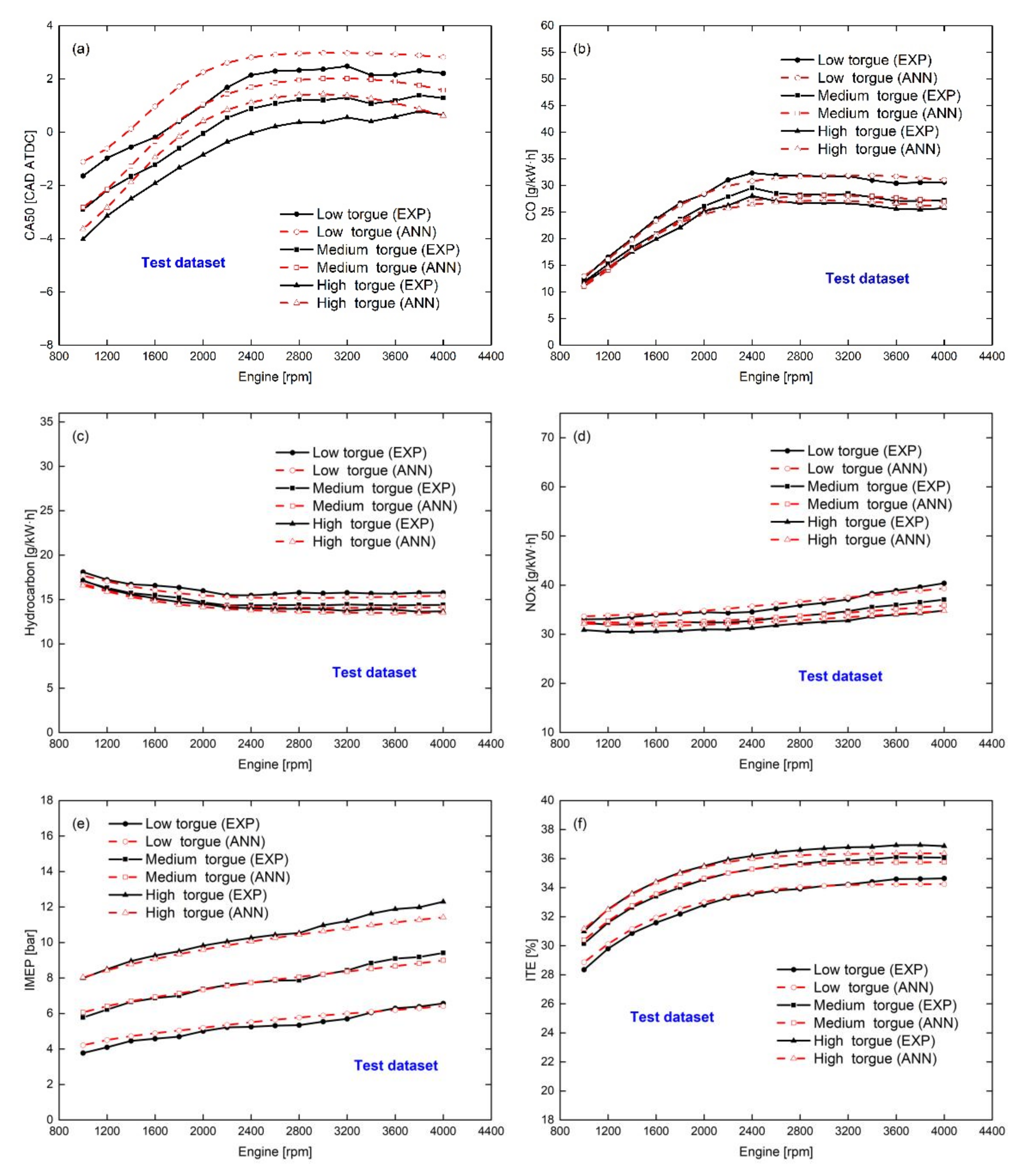
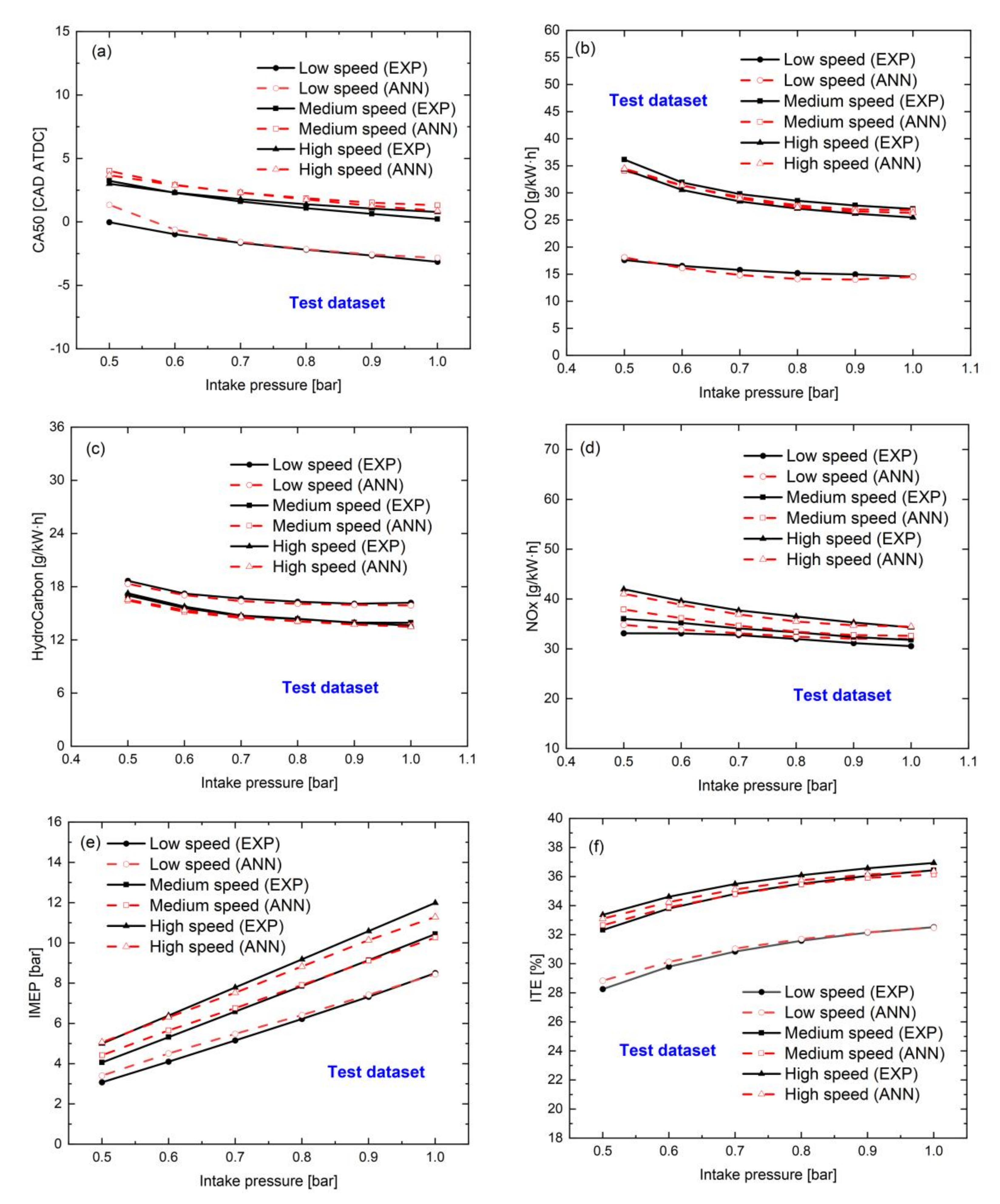
| References | Algorithm | Output | Main Conclusions |
|---|---|---|---|
| [40] | ANN, GBDT, RF, SVR | Exhaust gas temperature (EGT) | ANN is most appropriate for predicting EGT but is more complex for hyperparameter tuning. |
| [32] | K-nearest | Phase | Based on the unevenly distributed training set, the KNN model does not predict well. |
| [41] | ANN | Peak pressure rise | The ANN model can predict the relationship between pressure-based parameters and key control variables. |
| [42] | BDT | IMEP | The BDT model did not perform so well for low load operating conditions. |
| [43] | ANN | Fuel lubricity | The proposed neuron network can predict the lubricity well, using other diesel fuel properties as inputs. |
| [44] | ANN | Emissions | BP neural network can be used to predict emissions with the cetane number as the input parameter. |
| [45] | ANN | Emissions | ANN can be used for engine exhaust emissions modeling. |
| [46] | ANN | NOx | The ANN model is a good tool for NOx prediction if speed and torque are used as input parameters. |
| [47] | ANN | Torque, BSFC | The ANN model is very accurate for power class parameter prediction, and the prediction performance and accuracy are very good. |
| [48] | Neuron network | Thermodynamic properties | The gas thermodynamics properties can be evaluated with Elman neural network. |
| Research Type | Single-Cylinder |
|---|---|
| Cycle | 4-stroke SI PFI |
| Valves per cylinder | 2 |
| Bore [mm] × Stroke [mm] | 86 × 86.07 |
| Intake valve opens/closes | 9 CAD BTDC/84 CAD ABDC |
| Exhaust valve opens/closes | 55 CAD BBDC/38 CAD ATDC |
| Connecting rod length [mm] | 175 |
| Piston cup diameter [mm] | 80 |
| Piston cup depth [mm] | 5 |
| Wrist pin to crank offset [mm] | 1 |
| Compression ratio | 9.5 |
| TDC clearance height [mm] | 1 |
| ANN Structure | 3-7-6 | 3-7-7-6 | 3-5-5-6 |
|---|---|---|---|
| R2 (CA50) | 0.9956 | 0.9977 | 0.9907 |
| R2 (CO emissions) | 0.9499 | 0.9828 | 0.9687 |
| R2 (HC emissions) | 0.9751 | 0.9936 | 0.9755 |
| R2 (NOx emissions) | 0.9650 | 0.9899 | 0.9316 |
| R2 (IMEP) | 0.9838 | 0.9892 | 0.9923 |
| R2 (ITE) | 0.9755 | 0.9914 | 0.9829 |
| RMSE (CA50) | 0.8637 | 0.8353 | 1.2378 |
| RMSE (CO emissions) | 1.8098 | 1.0507 | 1.4158 |
| RMSE (HC emissions) | 0.7102 | 0.4659 | 0.7029 |
| RMSE (NOx emissions) | 2.3187 | 1.3946 | 3.2367 |
| RMSE (IMEP) | 0.2991 | 0.3060 | 0.2063 |
| RMSE (ITE) | 0.5168 | 0.3225 | 0.4264 |
| ANN Structure | 3-7-6 | 3-7-7-6 | 3-5-5-6 |
|---|---|---|---|
| R2 (CA50) | 0.9955 | 0.9978 | 0.9907 |
| R2 (CO emissions) | 0.9462 | 0.9796 | 0.9719 |
| R2 (HC emissions) | 0.9652 | 0.9878 | 0.9647 |
| R2 (NOx emissions) | 0.9475 | 0.9807 | 0.9138 |
| R2 (IMEP) | 0.9822 | 0.9875 | 0.9913 |
| R2 (ITE) | 0.9724 | 0.9916 | 0.9860 |
| RMSE (CA50) | 0.8931 | 0.8436 | 1.2541 |
| RMSE (CO emissions) | 1.8429 | 1.1291 | 1.3253 |
| RMSE (HC emissions) | 0.8997 | 0.6428 | 0.9041 |
| RMSE (NOx emissions) | 3.0659 | 2.0126 | 3.9147 |
| RMSE (IMEP) | 0.3057 | 0.3102 | 0.2131 |
| RMSE (ITE) | 0.5688 | 0.3330 | 0.3999 |
Publisher’s Note: MDPI stays neutral with regard to jurisdictional claims in published maps and institutional affiliations. |
© 2022 by the authors. Licensee MDPI, Basel, Switzerland. This article is an open access article distributed under the terms and conditions of the Creative Commons Attribution (CC BY) license (https://creativecommons.org/licenses/by/4.0/).
Share and Cite
Yang, R.; Yan, Y.; Sun, X.; Wang, Q.; Zhang, Y.; Fu, J.; Liu, Z. An Artificial Neural Network Model to Predict Efficiency and Emissions of a Gasoline Engine. Processes 2022, 10, 204. https://doi.org/10.3390/pr10020204
Yang R, Yan Y, Sun X, Wang Q, Zhang Y, Fu J, Liu Z. An Artificial Neural Network Model to Predict Efficiency and Emissions of a Gasoline Engine. Processes. 2022; 10(2):204. https://doi.org/10.3390/pr10020204
Chicago/Turabian StyleYang, Ruomiao, Yuchao Yan, Xiaoxia Sun, Qifan Wang, Yu Zhang, Jiahong Fu, and Zhentao Liu. 2022. "An Artificial Neural Network Model to Predict Efficiency and Emissions of a Gasoline Engine" Processes 10, no. 2: 204. https://doi.org/10.3390/pr10020204
APA StyleYang, R., Yan, Y., Sun, X., Wang, Q., Zhang, Y., Fu, J., & Liu, Z. (2022). An Artificial Neural Network Model to Predict Efficiency and Emissions of a Gasoline Engine. Processes, 10(2), 204. https://doi.org/10.3390/pr10020204







